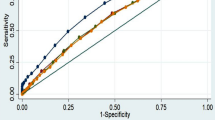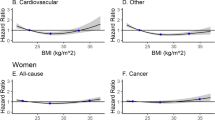Abstract
OBJECTIVE: To examine the effect of age on the relationship between body mass index (BMI) and waist circumference (WC), and the usefulness of BMI, WC and waist–hip ratio (WHR) in predicting mortality and cardiovascular risk in the elderly population.
DESIGN: Longitudinal observational study of 36 months duration.
SUBJECTS AND METHOD: A stratified random sample of 2032 Chinese subjects (990 male, 1033 female) mean age (s.d.) 80.1 (7.5), interviewed and examined at baseline and after 36 months. Deaths and presence of diabetes mellitus and hypertension were documented. A younger data set of 1010 subjects (500 male, 510 female), mean age (s.d.) 45.5 (11.6), was used for comparison of the BMI–WC relationship between younger and older subjects. In predicting outcomes using different values of BMI, WC and WHR, receiver operating characteristic curve analysis was used to derive cut-off values with optimal sensitivity and specificity, and the likelihood ratios for mortality, diabetes and hypertension for different anthropometric values were plotted.
RESULTS: The waist circumference values corresponding to BMI values of 25 and 30 kg/m2 were higher in elderly (92 and 103 cm for men; 88 and 99 cm for women) compared with younger subjects (85 and 97 cm for men; 78 and 88 cm for women). BMI and WC are inversely associated with mortality, in both men and women, positively associated with diabetes in men but not in women. WC was positively associated with hypertension in men and women. WHR was not associated with any outcome measures. The anthropometric measurement at the point of intersection of the likelihood curves for mortality and diabetes may be considered the optimum value, being BMI=21 kg/m2 for men and 25 kg/m2 for women, WC between 80 and 85 cm, and WHR 0.88–0.90.
CONCLUSION: Waist measurement values for predicting health outcomes in elderly people aged 70 y and over are different compared with younger subjects, and have similar predictive accuracy compared with body mass index. Waist–hip ratio is not a useful predictor.
This is a preview of subscription content, access via your institution
Access options
Subscribe to this journal
Receive 12 print issues and online access
$259.00 per year
only $21.58 per issue
Buy this article
- Purchase on Springer Link
- Instant access to full article PDF
Prices may be subject to local taxes which are calculated during checkout




Similar content being viewed by others
References
Cox BD, Whichelow MJ, Prevost AT . The development of cardiovascular disease in relation to anthropometric indices and hypertension in British adults Int J Obes Relat Metab Disord 1998 22: 966–973.
Taylor RW, Keil D, Gold EJ, Williams SM, Goulding A . Body mass index, waist girth, and waist-to-hip ratio as indexes of total and regional adiposity in women: evaluation using receiver operating characteristic curves Am J Clin Nutr 1999 69: 158–159.
Reeder BA, Senthilselvan A, Despres JP, Angel A, Liu L, Wang H, Rabkin SW . The association of cardiovascular disease risk factors with abdominal obesity in Canada. Canadian Heart Health Surveys Research Group Can Med Assoc J 1997 157 (Suppl 1): S39–45.
Grinker JA, Tucker KL, Vokonas PS, Rush D . Changes in patterns of fatness in adult men in relation to serum indices of cardiovascular risk: the Normative Aging Study Int J Obes Relat Metab Disord 2000 24: 1369–1378.
Okosun JS, Forrester TE, Rotimi CN, Osotimehin Bo, Muna WF, Cooper RS . Abdominal adiposity in six populations of West African descent: prevalence and population attributable fraction of hypertension Obes Res 1999 7: 453–462.
Lee JS, Kawakubo K . A useful index highly correlated with coronary risk factors for community based obesity screening Japanese J Public Health 1999 46: 89–102 (Japanese)
Ko GTC, Chan JCN, Woo J, Lau E, Yeung VTF, Chow CC, Wai HPS, Li JKY, So WY, Cockram CS . Simple anthropometric indexes and cardiovascular risk factors in Chinese Int J Obes Relat Metab Disord 1997 21: 995–1001.
Depres JP, Lemieux I, Prud'homme D . Treatment of obesity: need to focus on high risk abdominally obese patients Br Med J 2001 322: 716–720.
Lean ME, Han TS, Morrison CE . Waist circumference as a measure for indicating need for weight management Br Med J 1995 311: 158–161.
Cox BD, Whichelow MJ . Ratio of waist circumference to height is better predictor of death than body mass index Br Med J 1996 313: 1487–1488.
Han TS, VanLeer EM, Seidell JC, Lean MEJ . Waist circumference action levels in the identification of cardiovascular risk factor: prevalence study in a random sample Br Med J 1995 311: 1401–1405.
Ko GT, Tang J, Chan JC, Sung R, Wu MM, Wai HP, Chen R . Lower BMI cut-off value to define obesity in Hong Kong Chinese: an analysis based on body fat assessment by bioelectrical impedance Br J Nutr 2001 85: 135–136.
Ko GTC, Chan JCN, Cockram CS, Woo J . Prediction of hypertension, diabetes, dyslipidaemia or albuminuria using simple anthropometric indexes in Hong Kong Chinese Int J Obes Relat Metab Disord 1999 23: 1136–1142.
Molarius A, Seidell JC, Visscher TLS, Hofman A . Misclassification of high-risk older subjects using waist action levels established for young and middle-aged adults results from the Rotterdam Study J Am Geriatr Soc 2000 48: 1638–1645.
Kubena KS, McIntosh WA, Georghiades MB, Landmann WA . Anthropometry and health in the elderly J Am Dietet Assoc 1991 91: 1402–1407.
Woo J, Kwok T, Lau E, Li M, Yu LM . Body composition in Chinese Subjects relationship with age and disease Arch Gerontol Geriatr 1997 26: 23–32.
Folsom AR, Kaye SA, Sellers TA, Hong CP, Cerhan JR, Potter JD, Prineas RJ . Body fat distribution and 5-year risk of death in older women JAMA 1993 269: 483–487.
Woo J, Ho SC, Sham A, Yuen YK, Chan SG . Influence of age, disease and disability on anthropometric indices in elderly Chinese aged 70 y and above Gerontology 1995 41: 173–180.
Woo J, Leung SSF, Ho SC, Lam TH, Janus ED . Dietary intake and practices in the Hong Kong Chinese population in relation to chronic disease prevention J Epidemiol Community Health 1998 52: 631–637.
Zhao WH, Xu HQ, Zhang X, Wang JI, Yin CC, Li M, Chen JS . The association of BMI and WHR on blood pressure levels and prevalence of hypertension in middle-aged and elderly people in rural China Biomed Environ Sci 2000 13: 189–197.
Hsieh SD, Yoshinaga H, Muto T, Sakurai Y, Kosaka K . Health risks among Japanese men with moderate body mass index Int J Obes Relat Metab Disord 2000 24: 358–362.
Seidell JC, Perusse L, Despres JP, Bouchard C . Waist and hip circumferences have independent and opposite effects on cardiovascular disease risk factors: the Quebec Family Study Am J Clin Nutr 2001 74: 315–321.
Woo J, Ho SC, Sham A . Longitudinal changes in body mass index and body composition over 3 y and relationship to health outcomes in Hong Kong Chinese age 70 and older J Am Geriatr Soc 2001 49: 737–746.
Harris TB, Visser M, Everhart J, Cauley J, Tylavsky F, Fuerst T, Zamboni M, Taaffe D, Resnick HE, Scherzinger A, Nevitt M . Waist circumference and sagittal diameter reflect total body fat better than visceral fat in older men and women. The Health, Aging and body composition study Ann NY Acad Sci 2000 904: 462–473.
Schiffman SS . Perception of taste and smell in elderly persons Crit Rev Food Sci Nutr 1993 33: 17–26.
Lampe FC, Walker M, Lennon LT, Whincup PH, Ebrahim S . Validity of a self-reported history of doctor-diagnosed angina J Clin Epidemiol 1999 52: 73–81.
Bennett PH . Diabetes in the elderly: diagnosis and epidemiology Geriatrics 1984 39: 37–41.
Khaw KT, Wareham N, Luben R, Bingham S, Oakes S, Welch A, Day N . Glycated haemoglobin, diabetes, and mortality in men in Norfolk cohort of European prospective investigation of cancer and nutrition (EPIC-Norfolk) Br Med J 2001 21 (322): 15–18.
Author information
Authors and Affiliations
Corresponding author
Rights and permissions
About this article
Cite this article
Woo, J., Ho, S., Yu, A. et al. Is waist circumference a useful measure in predicting health outcomes in the elderly?. Int J Obes 26, 1349–1355 (2002). https://doi.org/10.1038/sj.ijo.0802080
Received:
Revised:
Accepted:
Published:
Issue Date:
DOI: https://doi.org/10.1038/sj.ijo.0802080
Keywords
This article is cited by
-
Gender differences in the association of obesity-related measures with multi-morbidity among older adults in India: evidence from LASI, Wave-1
BMC Geriatrics (2022)
-
The obesity paradox is mostly driven by decreased noncardiovascular disease mortality in the oldest old in China: a 20-year prospective cohort study
Nature Aging (2022)
-
Consumption of melatonin supplement improves cardiovascular disease risk factors and anthropometric indices in type 2 diabetes mellitus patients: a double-blind, randomized, placebo-controlled trial
Trials (2021)
-
Fitness, fatness and survival in elderly populations
AGE (2013)
-
Postprandial interleukin-6 response in elderly with abdominal obesity and metabolic syndrome
The Journal of nutrition, health and aging (2013)



